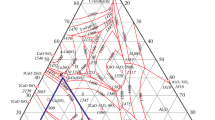Abstract
Bench and commercial-facility experiments have been performed on cold-crucible vitrification of a simulator of high-level wastes from the Savannah River site (USA). The wastes contained up to 29 mass% Fe2O3 and 26 mass% Al2O3. The specific product flow reached 1700 and 2450 kg/(m2·day) with specific energy consumption 14–16 and 9–10 kW·h/kg, respectively. The crucibles did not undergo any appreciable corrosion during the period of the work performed and are reusable. The product consisted of a borosilicate matrix, containing up to 10 vol.% crystalline phase of spinel. The method of induction melting in a cold crucible is especially effective for crucibles with a large diameter, since the specific productivity increases and the specific energy consumption on the vitrification of high-level wastes decreases.
Similar content being viewed by others
References
A. P. Kobelev, S. V. Stefanovskii, V. N. Zakharenko, et al., “Vitrification of a simulator of high-level wastes from the Savannah River site (USA) in a bench facility with a cold crucible,” At. É nerg., 102, No. 4, 225–232 (2007).
A. P. Kobelev, S. V. Stefanovskii, V. N. Zakharenko, et al., “Vitrification of a simulator of high-level wastes from the Savannah River site (USA) in a commercial facility with a cold crucible,” At. Énerg., 102, No. 5, 296–299 (2007).
J. Marra, D. Peeler, T. Edwards, et al., “Glass formulation to support an altered testing to demonstrate enhanced high level waste throughput,” in: Abstracts on MRS 2007 Scientific Basis for Nuclear Waste Management XXI, Sheffield, UK, September 16–21, 2007, p. 57.
H. Li, P. Hrma, J. Vienna, et al., “Effects of Al2O3, B2O3, Na2O, and SiO2 on nepheline formation in borosilicate glasses: chemical and physical correlations,” Non-Crys. Solids, 331, 202–216 (2003).
J. Marra, Sludge and Glass Compositions for Cold Crucible Induction Melter (CCIM) Testing — Sludge Batch 4, Savannah River National Laboratory, SRT-MST-2007-00070 (2007).
Standard Test Methods for Determining Chemical Durability of Nuclear, Hazardous, and Mixed Waste Glasses: The Product Consistency Tests (PCT), ASTM C1285-97 (1997).
J. Harbour, Summary of Results for Macro Batch 3 Variability Study, Report WSRC-TR-2000-00351 (2000).
Author information
Authors and Affiliations
Additional information
__________
Translated from Atomnaya Énergiya, Vol. 104, No. 5, pp. 291–295, May, 2008.
Rights and permissions
About this article
Cite this article
Kobelev, A.P., Stefanovskii, S.V., Lebedev, V.V. et al. Vitrification of a simulator of Savannah River site (USA) wastes with high iron and aluminum content on bench and commercial facilities with a cold crucible. At Energy 104, 381–386 (2008). https://doi.org/10.1007/s10512-008-9044-7
Received:
Published:
Issue Date:
DOI: https://doi.org/10.1007/s10512-008-9044-7




